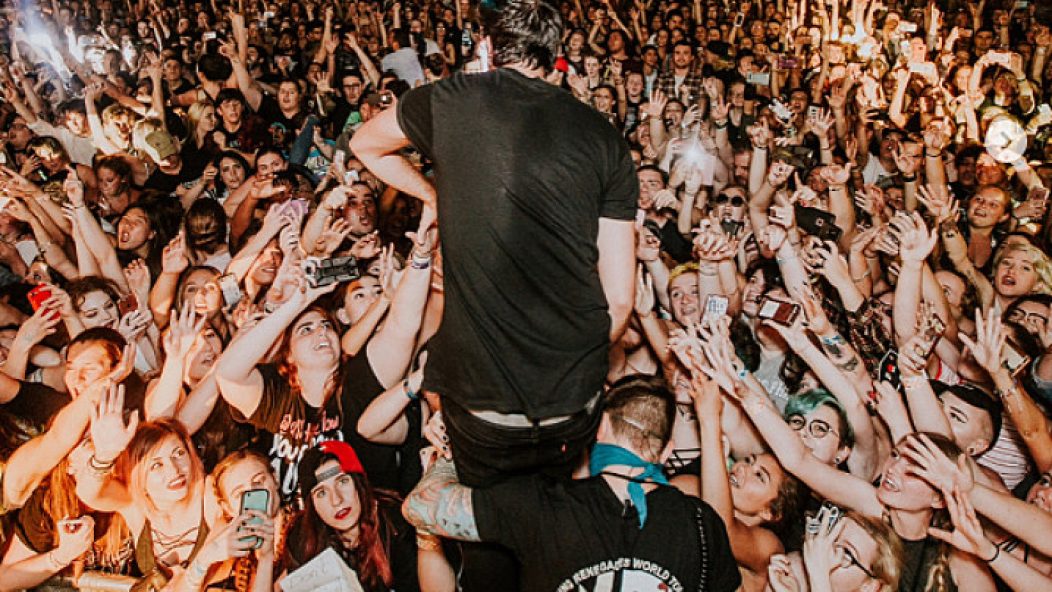
Op-Ed: Should you use your phone and record at shows?
In March, I stood in a packed stadium—the Verizon Center in Washington, DC—as Green Day rang out their hit “21 Guns.” Had this been 20 years ago, I would have been surrounded by the dim glimmer of hundreds of cigarette lighters sparkling out like little stars in a dark sky. Instead, the glow that surrounded me was a sea of LED lights, all projecting from the flash function of iPhones and Samsung Galaxies. While the moment seemed sincere, it also felt overwhelmingly artificial. Was the audience using these lights as an ode to the way we used to celebrate during large events back when Green Day first garnered radio success? Or were some of these fans videotaping the moment to share with those who couldn’t make it that night?
The biggest generational argument in the scene these days seems to revolve around one thing: whether it’s okay to record at a live show with a cellphone or not. It’s easy to think back to a recent show where the majority of the crowd was recording that time the singer stagedived instead of rushing to catch him, or how many people use Snapchat when they go crowdsurfing. This is such a common theme at shows that usually audience members overlook it until a phone gets in the way of their view or the internet blows up because the dude from Every Time I Die kicked a phone out of a guy’s hand for trying to take a stage selfie.
But, do we really need to review this footage? Or better yet, do most of us even remember having taken these videos? Yeah, seeing the guitarist crowd-walk is cool, and re-watching that epic wall of death might be interesting, but the overall quality will be atrocious. The sound won’t pick up properly; there will be tons of feedback and distortion; and most viewers won’t be able to even make out what song is playing in the background.
The root of this debate comes from an old-school idea of how shows are meant to be: They should be in the moment. Many argue that cellphones take away from the overall experience, while others refute that recordings allow for both their friends and selves to relive the adventures of the show. Each viewpoint offers fair pros and cons, but all arguments take place in one controlled setting: the safe, uncontroversial show. And if every show remained safe and without controversy, then I would agree with the musicians who punt phones into the audience, but unfortunately, that is not the case.
Phones have been used to show when bouncers wrongfully hurt fans, when bands attack fans, and when fans lash out. These moments caught “on tape” are far more important than any word of mouth or tweet. They are the groundwork laid to express a picture of what happened, and as the saying goes: A picture is worth a thousand words, but a video is worth even more.
The most recent, relevant instance of this happened during the 2017 Warped Tour. It’s no surprise that Warped always ends in major backlash from rumors constantly circulating—it’s the most famous, longest running touring festival in the world—but this time there was a lot of video evidence backing the situation. For those of you who don’t know, the Dickies, a punk band who have been around since 1977 (read: since before the dawn of cellphones) drew criticism after a video surfaced of their frontman Leonard Graves Phillips misogynistically calling out a member of the audience for protesting his band. I say “audience,” because it is very clear that this is not a fan of the band; this is a conscientious protester who happened to be on the tour as an acquaintance of feminist punk band War On Women .
It’s fair to argue that for a band who has been performing since the late ’70s, the idea of being constantly filmed is probably foreign. Saying outlandish things is totally punk rock, right? Maybe, but punk the way it originated died out a long time ago, and what remains is entirely digitized. It’s “punk” now to jump from rafters at shows, which is why so many artists do it and why so many fans feel compelled to videotape the event. It’s “punk” to rebel against Warped Tour’s “no crowdsurfing” rule (ead: you can’t sue us if you get hurt), which is why so many fans videotape themselves doing it—though I’m sure most are just doing it because that’s what you fucking do at a show.
The Dickies most definitely are in the wrong in this situation due to their chauvinistic and condescending response, regardless of whether they were provoked or not, but the truth of the matter is that this is probably the antics this band has had for the better part of four decades, only now is it shed in the light of the public eye. Whether the Dickies meant to offend so many people or not, this is something that we see all the time, just maybe not in quite the derogatory manner. I’ve seen many bands call fans out for disrespecting their sets. But the footage has never been evident until cellphones became additives to the show viewing experience.
The same can be said with fights at shows. It’s not a shocker, either, that Fat Mike of NOFX kicked a fan in the face who grabbed the mic from him a few years ago. Without video evidence, it’s an action that probably would have gone completely unnoticed, and probably has happened before, simply because older bands don’t take into account the severity of everything they do being recorded by idolizing fans. In my humble opinion, physical action against a fan is way worse than verbal, but NOFX received far less flack after inviting the kick-victim to retaliate in a recorded setting.
On the flipside, cameras at shows allow us to see band members as heroes. In 2014, the Story So Far’s frontman, Parker Cannon, saved a fan who was being attacked by a bouncer at Warped Tour. He literally jumped off the stage to defend the kid. This was all recorded and his actions joyfully lauded. Two years later, he would be recorded kicking a kid off the stage for trying to take a selfie with him. This may seem hypocritical at first, but it shows the dividing mentality between phones as nuisance versus phones as necessity.
Escaping the fact that the music industry has evolved into a highly digitized world is impossible. With the general population constantly hunched over an LED screen, it’s expected to see smartphones constantly jutting up above the crowd at shows and festivals. Many venues have tried to lessen this occurrence with technology that slows down cell service during set times or even go as far as applying a blocking sticker on a cellphone’s camera lens, but, at the end of the day, a cellphone at a show can lead to more good than harm with the imperative idea that everyone is always watching. There might be a sense of synthetic sincerity inside a stadium of cellular flashlights during “21 Guns,” but the overall intentions of the actions elicit similar results to those played out back in the ’70s or ’80s. Die-hard music fans and showgoers may rule against the nuisance, but the world is changing, and the way we interact with it is, too. Fans are no longer just fans. Fans with video footage represent witnesses.
What do you think: Should we put our cellphones away at shows? Vote below and weigh in in the comments.







